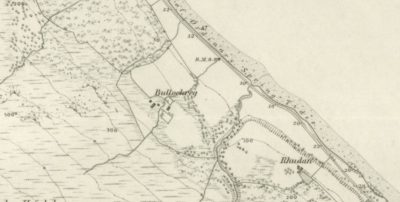Bullochreg Wood
When Bute Community Forest was formed, there were many areas of Sitka Spruce, Norway Spruce and Japanese Larch that were planted in the 1980s for future harvesting. One of these areas is Bullochreg Wood.
Back in 2023, the larch in this woodland was at significant risk of Phytophthora ramorum, a disease that eventually kills larch trees and for which there is no cure. To avoid the risk of these trees becoming infected and spreading the disease, after consulting with Scottish Forestry we decided it was time to harvest them. But this left us with the exciting opportunity, what should we do with this 30 acre area next?
We knew this was going to be one of our biggest woodland projects yet and as such deserved its own name. It was here we decided upon Bullochreg, named after the farm steading that once stood in the middle of this area. You can check out the full map of the North end of Bute from 1864 here!

Once this area was felled, it created a blank canvas and an opportunity for us to create 3 completely new habitats for Bute Community Forest with 1.7km of new paths for public access. Unlike the trees there before, we are planting with all native species to create habitats that will be here for hundreds of years!
Our 3 New Habitats
Scots Pine woodlands are an iconic forest which can also attract rarer bird species such as crossbills and provide another food source for Bute’s Red Squirrel population. Bute is somewhat south of its native range, however, Scots Pine can still be seen in some patches across Bute and more prominently on the Burnt Isles where it has been able to escape excessive grazing from deer. In this woodland, the new planting also includes Silver Birch and Rowan which again provide a great source of food for local wildlife before we move on to reintroducing ground plants such as common heather and bilberry to complete this habitat. It is hoped that when these trees mature this can be a source of natural regeneration for the North of Bute.
Planting in this area has been completed!
Although much of Moss Wood is considered wet woodland there is less than a combined total of 10m² of standing water across the entire area of Bute Community Forest. Freshwater ecosystems can be incredibly diverse and attract species that are already found in the community forest albeit they're currently much harder to find!
Here we are creating a Birch and Alder wetland with two larger ponds and lots of little flooded areas. We'll be planting, Downy Birch, Common Alder, Hawthorn, Rowan and Common Hazel in this habitat.
This area will attract amphibians (like frogs and newts) and freshwater invertebrates (like dragonflies and water beetles) and in time could attract other species of birds. Who knows, maybe in the future when this area becomes a healthy wetland habitat we could look even into the reintroduction of water voles...
Aspen trees are now incredibly rare across the UK. Aspen thrives in areas that have high disturbance and with so much of the UK's land management doing what it can to reduce disturbance, Aspen woodlands have disappeared leaving individual trees dotted around in some of the most remote locations.
We will be looking to work alongside Eadha Enterprises to replant this area with clones from isolated Aspen trees around Bute and the west coast of Scotland. One of the significant pressures that prevents Aspen expansion is that Aspen trees are dioecious and require both the male and female trees to be in flower at the same time and in the same location. By having this area containing the largest amount of male and female trees found anywhere on the west coast we stand a significantly higher chance of seed production!
These Aspen trees would eventually provide a source for future natural regeneration as well as create a habitat not found anywhere else in Argyll and Bute.
